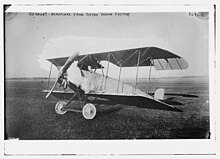This articleneeds additional citations forverification.(April 2014) |
Gothaer Waggonfabrik(Gotha,GWF) was a German manufacturer ofrolling stockestablished in the late nineteenth century atGotha.During the two world wars, the company expanded intoaircraftbuilding.
 | |
| Company type | Subsidiary |
|---|---|
| Industry | Rail transport |
| Founded | 1880 |
| Defunct | 1997 |
| Headquarters | Berlin,Germany |
Area served | Worldwide |
| Parent | Orenstein & Koppel |


World War I
editInWorld War I,Gotha was the manufacturer of a highly successful series ofbombersbased on a1914 designbyOskar Ursinusand developed by Hans Burkhard. From 1917, the Burkhard-designed twinpusherbiplane bomber aircraft were capable of carrying outstrategic bombingmissions overEngland,the first heavier-than-air aircraft used in this role. Several dozen of these bombers were built in a number of subtypes - the Ursinus-basedGotha G.I,and the succeeding Burkhard-designedG.II,G.III,G.IV,andG.V.This last variant was the most prolific, with thirty-six in squadron service at one point.
Inter war years
editWhilst Germany was prohibited from military aircraft manufacture by theTreaty of Versailles,Gotha returned to its railway endeavours, but returned to aviation with the rise of theNazigovernment and the abandonment of the Treaty's restrictions.
Auto-production 1921–1928
editIn 1921 the company purchasedAutomobilwerk Eisenach,thereby entering automobile production and, with theDixi 3/15 DA-1playing an important part in expanding the German auto-market to buyers who hitherto would have ridden motorcycles, if at all. The company encountered a cash crisis in 1928 and the Dixi branded auto-business was sold toBMW:the Dixi 3/15 DA-1 was rebadged in 1928 as theBMW 3/15 DA-2,the name by which today the little car is better remembered.
In 1924 theCyklon Maschinenfabrik,a manufacturer that had concentrated on motor-bikes and cycle cars came to be merged into the larger Gothaer Waggonfabrik business, through a rather indirect route of company purchases and sales. This gave Cyklon access to the viable sales and distribution network of Dixi and aspirations to become a serious auto-producer. Between 1927 and 1929 the company produced the Cyklon 9/40 which at the time was the most inexpensive six cylinder powered car sold in Germany. The conservative looking car featured a modern all-steel body produced by Germany's leading producer of steel car bodies,Ambi-Budd's Berlin based business.[1]It was, in fact, the first all-steel standard car body produced by Ambi-Budd in Berlin and, incongruously to some modern readers, was shared with theAdler Standard 6,a more powerful and higher priced six cylinder car from one of Germany's mainstream auto-makers of the 1930s. The sale by Gothaer Waggonfabrik of the cash-strapped Dixi business to BMW meant an end to Cyklon's access to a sales network, and highlighted the lack of cash for running the auto-business which rapidly fizzled out after 1928, although Cyklon was not formally wound up until 1931.[2]
World War II
editGotha's main contribution to the newLuftwaffewas theGotha Go 145trainer,of which 1,182 were built. The firm also produced theGotha Go 242assault gliderand licence-builtMesserschmitt Bf 110.Perhaps the most famous Gotha product ofWorld War II,however, was an aircraft that never entered service, theHorten Ho 229.This was an exoticjet-powered,flying wingfighter aircraftdesigned by theHorten brothers,who lacked the facilities to mass-produce it. Two prototypes flew, the second (powered) version lost in an accident on its third flight. The third prototype- built to a modified design - was almost complete and four more were in various stages of manufacture before the end of the war. The Ho 229 V3 ended up in American hands, and is currently at theNASM'sUdvar-Hazy Center,under evaluation for restoration.
On 22 February 1944, a squadron of American bombers was sent from Britain to bomb the factory, but due to bad weather, the mission was cancelled before they reached Gotha. On the way back, the Dutch border city ofNijmegen was bombedinstead as a 'target of opportunity', killing hundreds of civilians.
On 24 February 1944, 239 AmericanB-24sare dispatched to the primary target at Gotha, Germany (169 bomb Gotha); the lead bombardier from 2AD suffered from anoxia due to a faulty oxygen mask and mistookEisenachas the primary target, 43 other B-24s released on his mistake (44 bomb Eisenach); they claim 50-10-20 Luftwaffe aircraft; 34 B-24s are lost and 29 are damaged; casualties are: 3 KIA, 6 WIA and 324 MIA.[3]
Post war
editFollowing the war, Gotha once again returned to its original purpose, buildingtramsandlight railvehicles in the formerEast Germany.The tram production ended in 1967, after East Germany started importingČKD-Tatratrams from Czechoslovakia.
From 1983 on, parts for theWartburg535/1.3were produced. After the end of theWartburg production in Eisenachafter 1991 the production concentrated on truck trailers. In 1997 the company was split and privatized by theTreuhandanstalt.
Today theSchmitz Cargobull Gotha GmbH(production site ofSchmitz Cargobull AG) produces around 4000 truck trailers per year. The second successor is theGothaer Fahrzeugtechnik GmbH,which produces lattice mast elements formobile cranesand welded components.
List of aircraft
editGotha aircraft included:
- Gotha B.I/II
- Gotha G.I
- Gotha G.II
- Gotha G.III
- Gotha G.IV
- Gotha G.V
- Gotha G.VI
- Gotha G.VII
- Gotha G.IX
- Gotha G.X
- Gotha LD.1
- Gotha WD.2
- Gotha WD.3
- Gotha WD.7,seaplane trainer, 1916
- Gotha WD.11,
- Gotha WD.14,
- Gotha WD.27,
- Gotha Go 145,trainer
- Gotha Go 146,small transport (twin-engine), 1935
- Gotha Go 147,STOL reconnaissance (prototype)
- Gotha Go 149,military trainer, two built
- Gotha Go 150,light aircraft
- Horten Ho 229,fighter (flying-wing), Gotha was selected for mass-production
- Gotha Go 242,transport glider
- Gotha Go 244,transport
- Gotha Go 345,assault glider
- Gotha Ka 430,transport glider
- Gotha Taubea variation of theEtrich Taube
See also
editReferences
edit- ^Oswald,pp 82 & 438
- ^Oswald,p 438
- ^"Eighth Air Force Historical Society".www.8thafhs.org.Archived fromthe originalon 18 January 2019.Retrieved21 August2018.
- Oswald, Werner (2001).Deutsche Autos 1920-1945, Band (vol) 2(in German). Motorbuch Verlag.ISBN3-613-02170-6.